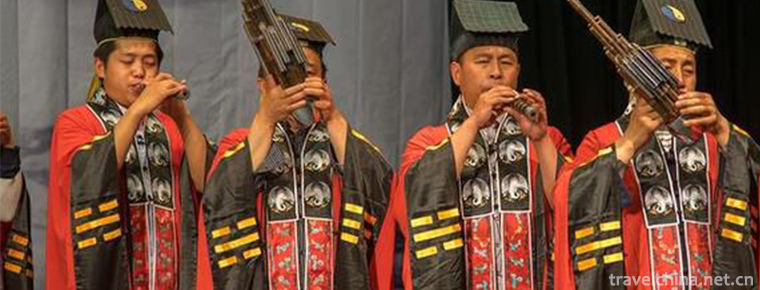Sheng Guanyue in Jizhong
Sheng Guanyue in Jizhong
Jizhong Sheng wind music is popular in Jizhong Plain, that is, south of Beijing, west of Tianjin, north of Cangzhou and Dingzhou frontline nearly 30 counties and cities of traditional drum music varieties, the local folk commonly known as "concerts".
In 2006, Jizhong Sheng Music was listed in the first batch of national intangible cultural heritage list with the approval of the State Council.
historical origin
Jizhong Sheng wind music is popular in Jizhong Plain, that is, south of Beijing, west of Tianjin, north of Cangzhou and Dingzhou, nearly 30 counties and cities of drum music varieties, folk commonly known as "concerts". It is also called "Sheng Guan Music" because it is mainly composed of pipes, Sheng and other accompaniments. In addition to Sheng and wind instruments, there are also Yungong, flute and percussion instruments such as drums, cymbals, clang and so on. There are three types of music: divertimento, ditty and independent percussion. The divertimento is a major part of Sheng wind music because of its long length and complex structure. "Sheng Guanyue" spreads all over the central Hebei Plain. Farmers from all over the country, taking villages as units, play and inherit in local folk activities such as sacrifices, ceremonies and funerals by means of music festivals.
Jizhong wind music was originally played in two forms: the North Concert and the South Concert. "Beiyuequan" orchestra is composed of eight to ten people. The pipes of the main musical instruments are thin, small in volume, soft in pronunciation, simple and dignified in playing style, slow in speed and elegant. The Orchestra of "South Concert" is usually composed of more than ten people. The pipes of the main instrument are thicker. Besides one pipe as the main pipes, they are also equipped with multi-payment pipes. Therefore, they play with loud voice, changeable melody, lively and interesting playing style, faster speed and warmer. In recent decades, the "South Music Club" has become less and more popular and widely spread, becoming the representative of the central Hebei wind orchestra.
Inheritance significance
In the late Qing Dynasty, the concert of Shengfang Town in Bazhou began to receive both Gaoqiang and Kunqu Opera, and became the largest music association in the town. After the founding of New China, Kunqu Opera gradually faded out, but so far musicians can still play Kunqu Opera. In many local concerts, the grand array of banners, corner lights, drums, tea picks and so on formed the characteristics of Zhennan concert. The performances, formations and related artifacts with unique styles of Shengfang Zhennan Concert are the real relics of Buddhist music in the folk, and are also important materials for understanding and studying classical Buddhist music and local folk customs.
The state attaches great importance to the protection of intangible cultural heritage. On May 20, 2006, Shengguan Music in Jizhong was approved by the State Council and listed in the first batch of national intangible cultural heritage list.
Due to various factors, Qujiaying concert, Gaoluo concert, Gaoqiao concert and Shengfang concert are facing great difficulties in inheritance. Only by strengthening protection, can we inherit this excellent folk cultural heritage.


-
1.Tiger Leaping Gorge
Tiger Leaping Gorge, known as "danger", is one of the deepest canyons in China
Time 2018-10-17 -
2.Shanghai Science and Technology Museum
Shanghai Science and Technology Museum is a comprehensive natural science and technology museum with Chinese characteristics, times characteristics and Shanghai characteristics
Time 2018-12-05 -
3.Guilin Yijiang Margin Scenic Spot
Guilin Yijiang Rim Scenic Spot is situated on the northwest tour line of Guilin with long corridor. It is 32 kilometers away from the urban area (321 National Highway Lingui Wutong Town Section).
Time 2019-01-13 -
4.Huangshan Yi Culture Tourist Area
Huangshan Yi Cultural Park is a national AAAA-level tourist attraction, located in the northwest of Linyi Economic and Technological Development Zone.
Time 2019-01-18 -
5.Furniture Making Skills
Ming-style furniture making skills, local traditional handicraft in Suzhou City, Jiangsu Province, one of the national intangible cultural heritage.
Time 2019-05-05 -
6.Miao Flower Jumping Festival
Flower Dancing Festival is a traditional festival of the Miao people in Anshun. Legend has it that Yang Lu, a hero of the Miao people, rose up. Till now, Huashan, outside the North Gate of Anshun, is
Time 2019-06-05 -
7.Wood movable type printing technology
Dongyuan Village is located in the southwest of Ruian City, Zhejiang Province. According to the local "Wang's genealogy of Taiyuan County", in the early Yuan Dynasty, Wang Famao, a hermit in
Time 2019-06-06 -
8.Da Zang Temple
Located in the north of malkang County, dazang temple is about 500 kilometers away from Chengdu City and is located in the deep mountains above 3000 meters above sea level.
Time 2020-11-07 -
9.Ecological environment of Luzhou
On July 5, 2019, the Ministry of ecology and environment of the people's Republic of China announced the special investigation of black and odorous water bodies in the first stage of overall planning and strengthening supervision in 2019. Luzhou was listed in the "list of cities whose
Time 2020-12-14 -
10.Mianyang economy
In 2019, the gross domestic product (GDP) of Mianyang City will reach 285.620 billion yuan, which will increase by 8.1% according to the comparable price. The growth rate is 0.6 percentage points higher than the average level of the whole province.
Time 2020-12-14 -
11.Suining science and technology
In 2019, Suining achieved a high-tech industry revenue of 50.2 billion yuan, an increase of 22.4%, and social R & D investment reached 860 million yuan, a year-on-year increase of 37.3%, and the investment intensity reached 0.7%. In the whole year,
Time 2020-12-16 -
12.Leshan secondary industry
In 2019, the industrial added value of Leshan City is 68.028 billion yuan, an increase of 8.8% over the previous year, accounting for 36.5% of the city's GDP, driving economic growth by 4.0 percentage points and contributing 52.8% to economic growth.
Time 2020-12-17